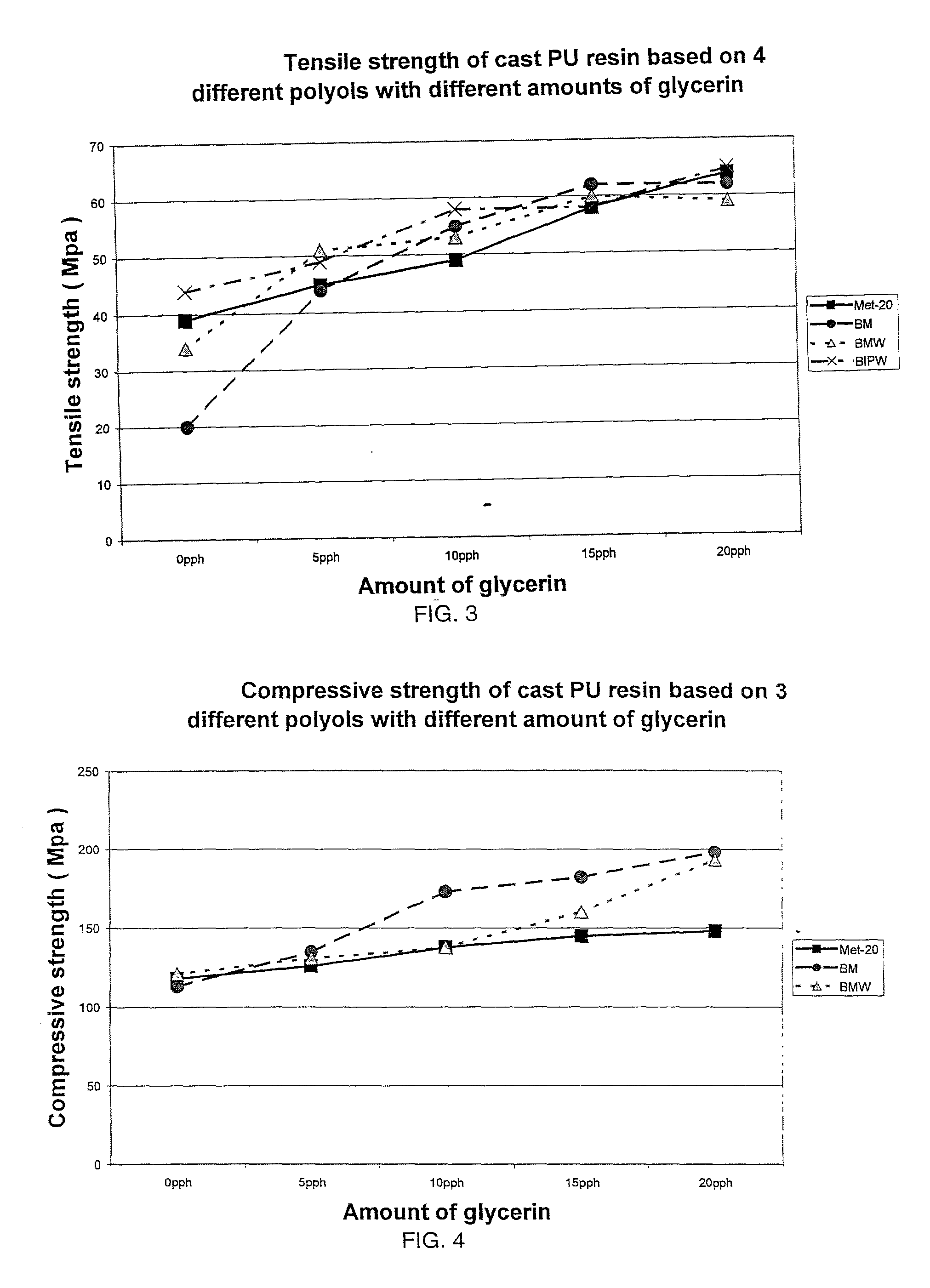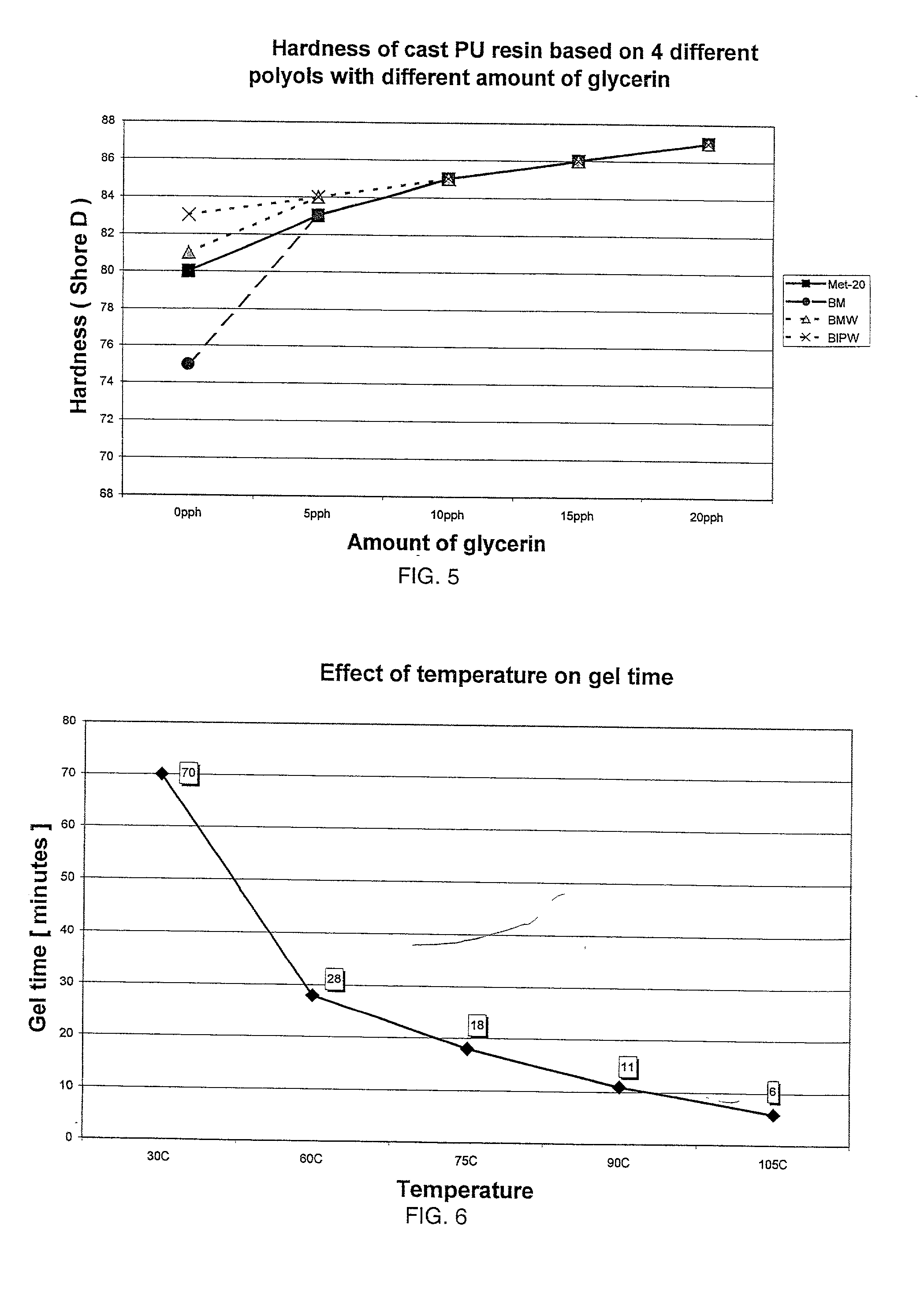Polymer concrete and method for preparation thereof
- Summary
- Abstract
- Description
- Claims
- Application Information
AI Technical Summary
Benefits of technology
Problems solved by technology
Method used
Image
Examples
example 2
Structural Properties of MET20 Polyol Resins
[0105] Eight cast polyurethane samples formed from soy-polyol Met-20 were prepared with different amounts of glycerin. The equivalent ratios of Met-20 and glycerin, expressed as parts per hundred by weight of the polyol, were:
[0106] 10 / 0 (0 pph glycerin, total OH#=208);
[0107] 9 / 1 (1.3 pph glycerin, total OH#=229);
[0108] 8 / 2 (2.8 pph glycerin, total OH#=252);
[0109] 7 / 3 (4.9 pph glycerin, total OH#=284);
[0110] 6 / 4 (7.6 pph glycerin, total OH#=322);
[0111] 5 / 5 (11.3 pph glycerin, total OH#=373);
[0112] 4 / 6 (17.1 pph glycerin, total OH#=444); and
[0113] 3 / 7 (26.5 pph glycerin, total OH#=548).
[0114] Aliquots of the eight MET20 polyol-glycerine mixtures described above were placed in a container and charged with PAPI.RTM. 2901 a polymeric methylene diphenyl diisocyanate (PMDI) from The Dow Chemical Company to provide an NCO / OH equivalent ratio of 1:1 in the resin mixture. The reagents were mixed to homogeneity for two to three minutes. Air bubbles ...
example 3
Structural Properties of BM Polyol Resins
[0116] Eight cast resin samples were prepared using the soy-polyol BM that is described in Example 1, in combination with different amounts of glycerine. The equivalent ratios of BM polyol and glycerin were:
[0117] 10 / 0 (0 pph glycerin, total OH#=181);
[0118] 9 / 1 (1.1 pph glycerin, total OH#=199);
[0119] 8 / 2 (2.5 pph glycerin, total OH#=221);
[0120] 7 / 3 (4.2 pph glycerin, total OH#=248);
[0121] 6 / 4 (6.6 pph glycerin, total OH#=283);
[0122] 5 / 5 (9.9 pph glycerin, total OH#=329);
[0123] 4 / 6 (14.8 pph glycerin, total OH#=394); and
[0124] 3 / 7 (23.1 pph glycerin, total OH#=490).
[0125] Aliquots of the eight BM cast samples were mixed with an equivalent isocyanate moiety from PAPI.RTM. 2901 and hardened in an identical manner with respect to the cast resins of Example 2. The structural properties of each BM resin were determined according to the procedures described above and are shown in Table 3 below.
3TABLE 3 Properties of Cast Resin Based On BM Polyol Gl...
example 4
Structural Properties of BMW Polyol Resins
[0127] Five cast resin samples were formed using the soy-polyol resin BMW that is described in Example 1, in combination with different amounts of glycerine. The relative amounts of BMW polyol and glycerin were:
[0128] 0 pph glycerin (total OH#=207);
[0129] 5 pph glycerin (total OH#=289);
[0130] 10 pph glycerin (total OH#=359);
[0131] 15 pph glycerin (total OH#=423); and
[0132] 20 pph glycerin (total OH#=482).
[0133] Aliquots of the eight BM cast samples were mixed with an equivalent isocyanate moiety from PAPI.RTM. 2901 and hardened in an identical manner with respect to the cast resins of Example 2. The structural properties of each BM resin were determined according to the procedures described above and are shown in Table 4 below
4TABLE 4 Properties Of Cast polyurethane Samples Based On Polyol BMW Glycerin Tg Flexural Tensile Compressive content (DSC, Modulus Strength Strength Hardness (pph) .degree. C.) (Mpa) (Mpa) (Mpa) (Shore D} 0 85 1417 34 ...
PUM
| Property | Measurement | Unit |
|---|---|---|
| Fraction | aaaaa | aaaaa |
| Fraction | aaaaa | aaaaa |
| Fraction | aaaaa | aaaaa |
Abstract
Description
Claims
Application Information
 Login to View More
Login to View More - R&D
- Intellectual Property
- Life Sciences
- Materials
- Tech Scout
- Unparalleled Data Quality
- Higher Quality Content
- 60% Fewer Hallucinations
Browse by: Latest US Patents, China's latest patents, Technical Efficacy Thesaurus, Application Domain, Technology Topic, Popular Technical Reports.
© 2025 PatSnap. All rights reserved.Legal|Privacy policy|Modern Slavery Act Transparency Statement|Sitemap|About US| Contact US: help@patsnap.com



